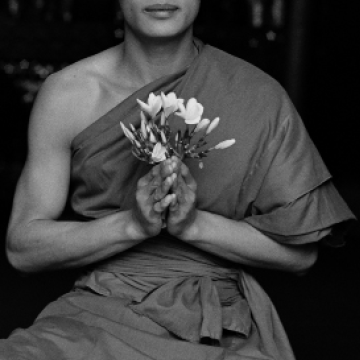
This issue’s “Becoming Buddha” completes Douglas Penick’s four-part series on the “four sights” or “divine messengers,” which, legend tells us, compelled the historical Buddha to leave the comfort of home for the spiritual life. It’s not often that we run a year-long series, but the lyrical strength and clarity of Douglas’s writing convinced us that the readership would welcome, and even look forward to, each installment. We were right. The response has been enthusiastic, reinforcing our commitment to publishing work that requires from readers a quality of attention that may seem rare nowadays.
When I told Douglas how popular the series is, he replied, “It must be the pictures.” While the images accompanying the pieces—in this issue, Hans Georg Berger’s photographs (see right)—have indeed done them justice, we think Douglas is too modest. And according to managing editor Emma Varvaloucas, who first suggested that we run the series, he is a delight to work with.
Contributions from longtime students of the dharma like Douglas (an early student of Chögyam Trungpa Rinpoche’s) are always a great gift, and our summer lineup is especially strong in this respect. In “On Dignity,” Sallie Tisdale, who appeared on Tricycle’s masthead before I did, writes of our inherent self-worth. Another veteran, writer and practitioner Natalie Goldberg, reflects on her decades-long relationship with meditation. (Like any relationship, it’s complicated.) Newer to our pages but not to the dharma, Kurt Spellmeyer explores generosity in a debt-driven market economy, arguing that mutual indebtedness is a good thing (“Buddhism and the Market”), while Myokei Caine-Barrett (“Our Common Thread)” examines the underlying tenets that Buddhists of all traditions share. This issue of Tricycle wouldn’t be complete, however, without the sort of twist that gets a few readers hot under the collar: editor-at-large Mary Talbot’s interview with scholar Shayne Clarke (“Rules for Pregnant Nuns and Married Monks”) tells us that life among the early monastics was not necessarily as celibate as we assume it was.
Good news: shortly before we went to press, we launched our all-new website, tricycle.org (see facing page). Gone is the old .com, originally created in 1995, which perhaps has given readers the wrong impression: the Tricycle Foundation, which publishes Tricycle and hosts its website, has been a nonprofit from the start, and we’ve decided to make its status clear by switching the site’s name to tricycle.org. The site is mobile-friendly (I can hear sighs of relief out there), easily navigable, and full of inspiration and ideas to explore, from now-classic interviews in the archives to a new and up-to-date directory of institutions where you can pursue Buddhist studies in the United States.
Perhaps best of all, the new website is entirely funded by our readers and friends. When we asked for help to build the site, the readership responded generously. The Tricycle board and staff offer our deepest gratitude to our ever-growing community in print and online. Your commitment and support have seen us into our 25th year. Thank you!
Thank you for subscribing to Tricycle! As a nonprofit, we depend on readers like you to keep Buddhist teachings and practices widely available.